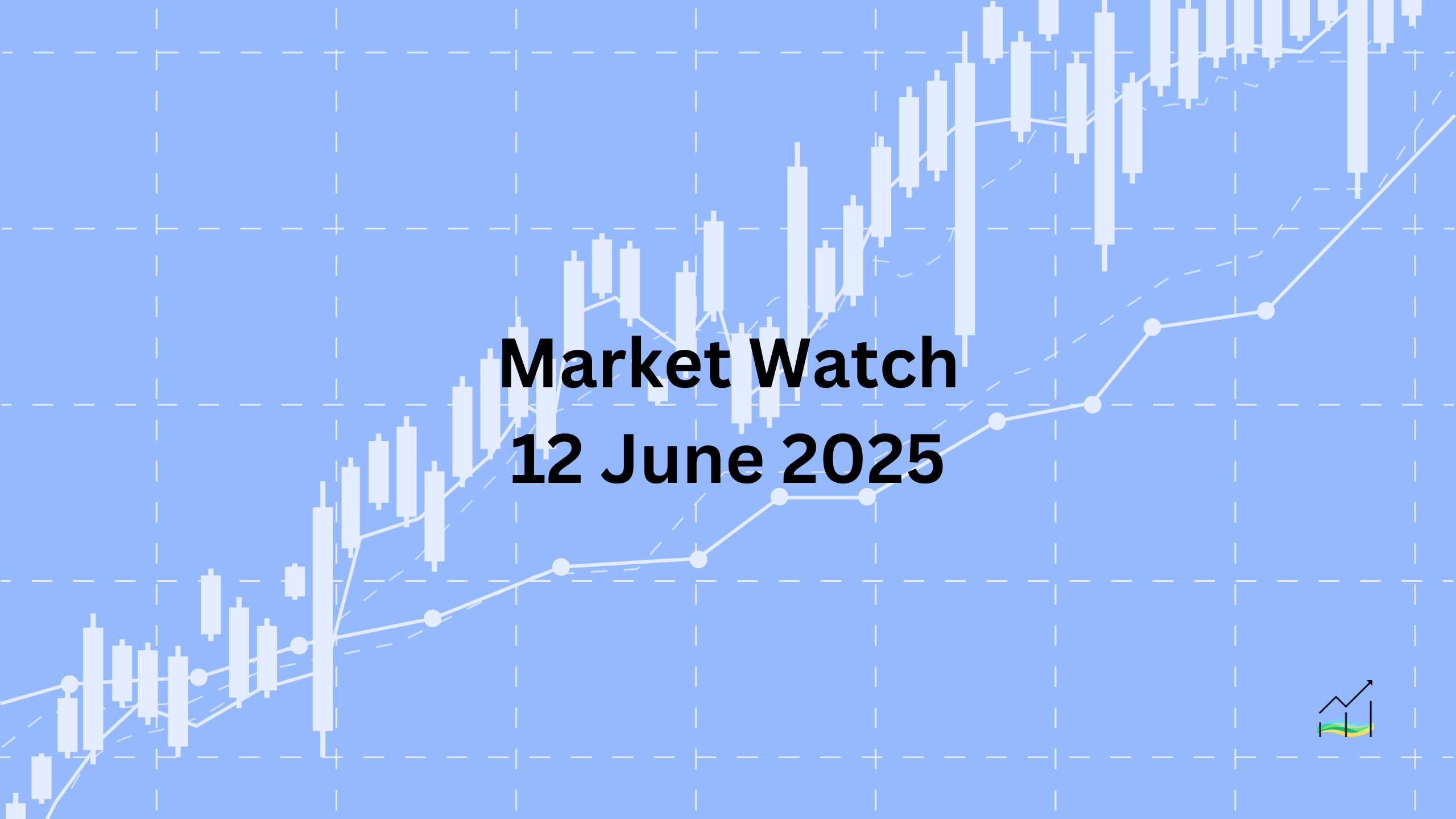12/06/2025 Market Watch

Markets Rattled by Geopolitics, Bonds & Gold Find Support
Key Takeaways:
- Market sentiment remains risk-off, but not dollar-driven
- Trump’s tariff rhetoric and Middle East tensions stoke uncertainty
- US dollar broadly weaker except against Mexican peso
- Gold is firm but volatile, hovering near $3360
- Global equities under pressure, led by Asia and Europe
- US and European bond yields retreat amid flight to safety
- Oil hits a 2-month high before reversing near key support
Financial markets are navigating a complex risk landscape this week, driven by geopolitical tensions and shifting sentiment. Former President Trump has reignited tariff concerns with new threats of bilateral trade action, while rising tensions in the Middle East, particularly involving Iran, have added further pressure. These developments typically trigger a stronger US dollar and higher gold prices, yet that familiar pattern has not fully emerged. Instead, the dollar is broadly weaker against both G10 and emerging market currencies, with the notable exception of the Mexican peso, which hit a nine-month high.
Gold has seen renewed buying interest but remains volatile. After reaching a weekly high near $3378, it pulled back to around $3339 before regaining ground to trade in the $3360 range. Equities continue to suffer globally. Hong Kong and mainland Chinese stocks posted losses of over 1%, while Europe’s Stoxx 600 is down for the fourth consecutive day. US equity futures also point to a weaker open, reflecting investor caution.
Bond markets are benefitting from the prevailing risk aversion. European yields are down 4 to 6 basis points, and the US 10-year Treasury yield has fallen to approximately 4.38%. Today’s $22 billion US 30-year bond auction adds another layer of uncertainty, with yields slipping to a four-day low near 4.88% ahead of the sale. In commodities, crude oil saw a temporary spike to $69.30, its highest in two months, before reversing sharply to trade near $67.00, testing the 200-day moving average. These movements underscore the market’s sensitivity to geopolitical signals, even as traditional safe haven flows remain fragmented.
United States of America
Overview
The US dollar came under pressure following a softer-than-expected CPI print, yet rate expectations have only modestly shifted. Despite the weak inflation data, the Fed funds futures market continues to price in less than two full rate cuts for 2025. Meanwhile, former President Trump has resurfaced in the trade policy space, announcing intentions to issue letters within two weeks that would notify trading partners of new bilateral tariffs. At the same time, Treasury Secretary Bessent, who is reportedly under consideration to succeed Jerome Powell, stated that Trump may opt to extend the postponement of reciprocal tariffs.
Geopolitical tensions have also escalated. Reports confirm that the US is evacuating non-essential embassy personnel across several Middle East locations. This follows intensified rhetoric against Iran, now formally accused by the International Atomic Energy Agency of breaching its nuclear obligations. These developments have injected caution into markets despite recent signs of disinflation.
On the data front, May's producer price index (PPI) is expected to show a moderate rebound, supporting the broader narrative of sticky but easing inflation. Jobless claims are also due and are likely to show further softening in the labor market. Although employment trends remain stable, they are cooling slowly enough for the Federal Reserve to maintain its cautious stance.
Economic Drivers
- Softer CPI data has weighed on the dollar but has not fully shifted rate cut expectations.
- Trump intends to announce new tariffs via formal letters within two weeks.
- Treasury Secretary Bessent hinted at a possible extension of the reciprocal tariff delay.
- Rising geopolitical tensions in the Middle East have triggered the evacuation of non-essential US diplomatic staff.
- The IAEA reports that Iran is no longer in compliance with its nuclear obligations.
- The labor market is cooling gradually, giving the Fed space to hold its restrictive stance.
Data and Events
- 12 June 2025: 10-y Bond Auction.
- 12 June 2025: PPI.
- 12 June 2025: Unemployment Claims.
Price Action
- Dollar Index failed to sustain gains above 99.40 and has reversed lower.
- Support seen at 97.90, the April low, with further downside toward 97.45.
- A small gap between Wednesday’s low and Thursday’s high has been filled.
Key Points:
- The dollar is under pressure following weak CPI data.
- Trump’s tariff threats and Middle East instability are creating geopolitical headwinds.
- May PPI and jobless claims will help refine inflation and labor outlooks.
- Dollar Index has broken below technical support, signaling further downside.
China
Overview
Although the US dollar was broadly weaker, it temporarily surged to a six-day high against the offshore yuan, briefly exceeding CNH7.20 before retreating. This movement nearly completed a 61.8% retracement of the month’s prior decline. The yuan later strengthened, bringing the dollar down near this week’s lows, just below CNH7.1780, with the broader low for the year recorded in late May around CNH7.1615.
The People's Bank of China set the daily reference rate at CNY7.1803, its third consecutive lower fixing and the weakest level since early April. This suggests an intentional move by Chinese authorities to allow modest currency appreciation amid stabilising capital flows or diplomatic considerations.
On the geopolitical front, attention remains on China’s decision to issue six-month export licenses for rare earths and magnets to US firms. The strategic significance of these materials is considerable, as both the US and China hold leverage over global supply chains. While the exact terms of the arrangement remain unclear, the license duration and policy context imply ongoing negotiations. There is growing recognition that alternative sourcing for China's rare earth processing is difficult and expensive, which could prompt increased state support in the US, Europe, and Japan across critical sectors like semiconductors and petrochemicals.
Economic Drivers
- The yuan strengthened following a brief spike in the dollar, suggesting reactive capital flows.
- PBOC’s third consecutive lower fix indicates deliberate currency management.
- China issued six-month export licenses for rare earths and magnets to US companies.
- The agreement signals mutual dependency in key global supply chains.
- Substitution for China's processed rare earths remains costly and difficult.
- The US and its allies may require additional state support to reduce reliance on Chinese supply chains.
Data and Events
No major economic releases are scheduled today.
Price Action
- USD/CNH briefly exceeded CNH7.20, nearing the 61.8% retracement of the recent decline.
- The pair pulled back near weekly lows just below CNH7.1780.
- Year-to-date low remains near CNH7.1615, recorded in late May.
Key Points:
- Yuan strengthened after a short-lived dollar rally.
- PBOC continues to guide the currency lower through its daily fix.
- Rare earths deal highlights strategic interdependence between the US and China.
- Supply chain realignment will likely need government backing in the West.
- Technical pressure remains on USD/CNH toward key support levels.
Europe
Overview
The euro surged to $1.15 yesterday and extended gains to around $1.1565 today, marking its strongest level since late April and nearing the 2024 high of $1.1575 reached on April 21. This level had not been tested since October 2021. The rally was driven largely by broad-based US dollar weakness following softer-than-expected US CPI data, which gave the market the green light to reduce dollar exposure. The euro became the primary beneficiary of this shift, reflecting a move back into European assets despite underlying economic concerns.
However, the macro backdrop in the eurozone remains weak. While today's data calendar is quiet, tomorrow brings a series of industrial production and trade figures that may reinforce the slowdown narrative. National data from Germany, France, and Spain already point to a steep drop in April industrial activity. Germany and France each reported declines of 1.4%, while Spain's output contracted by 0.8%. Italy was the only major economy to register growth, with a modest 1% increase. Forecasts suggest the eurozone's aggregate industrial production may have fallen by 1.7% in April, which would be the sharpest monthly contraction since July 2023.
Trade figures are also expected to deteriorate. The eurozone’s seasonally adjusted trade surplus is projected to narrow significantly to 18.3 billion euros in April from 27.9 billion in March. Although still larger than most months in 2023, such a sharp contraction, around 35%, underlines weakening export momentum amid sluggish global demand.
Economic Drivers
- Euro strength driven by broad US dollar weakness after soft US inflation data.
- Limited resistance ahead for the euro following recent breakout levels.
- Weak industrial production across Germany, France, and Spain in April.
- Italy recorded marginal growth, contrasting with contractions elsewhere.
- Eurozone aggregate output expected to post the largest decline since July 2023.
- Trade surplus forecast to narrow by 35% in April, reflecting slower export activity.
Data and Events
No major economic releases are scheduled today.
Price Action
- EUR/USD broke above $1.15 and reached $1.1565, close to the year’s high.
- April’s high at $1.1575 is a critical level, last seen in October 2021.
- A sustained break above $1.1575 opens the door to $1.1685–$1.1700.
Key Points:
- Euro rallied sharply on dollar weakness, approaching multi-year highs.
- Industrial output across the bloc is showing signs of broad contraction.
- Trade surplus is expected to narrow but remains above 2023 averages.
- Limited resistance ahead could fuel further euro strength if data underwhelms.
Japan
Overview
The Japanese yen experienced significant volatility following the latest US inflation report. The dollar initially climbed to a nine-day high near JPY145.45 but reversed sharply after the softer-than-expected CPI data, falling to around JPY144.35. The pair briefly recovered but faced renewed selling near JPY145.20, eventually dropping to almost JPY143.65. If momentum continues, the next area of interest lies between JPY142.00 and JPY142.50. This reflects renewed yen strength as markets recalibrate rate expectations and reposition around safe-haven demand.
Capital flow data also offers insight into shifting investment behaviour. In the final week of May, Japanese investors offloaded JPY1.144 trillion in foreign equities, marking their third-largest weekly sale since the end of 2022. This was followed by an additional JPY149 billion in foreign equity sales during the first week of June. At the same time, foreign investors turned net buyers of Japanese bonds, purchasing JPY1.165 trillion at the end of May and JPY220 billion more in early June. Meanwhile, Japanese investors reduced their exposure to foreign bonds, selling JPY459 billion last week after JPY118 billion in the prior week. On the equity front, offshore accounts continued to show appetite for Japanese stocks, purchasing JPY180 billion after a JPY336 billion acquisition the week before.
These flows suggest a tentative rotation back into Japanese assets, especially fixed income, while local investors remain cautious on global risk exposure.
Economic Drivers
- Yen volatility driven by US CPI reaction and market positioning.
- Japanese investors sold large volumes of foreign equities in late May and early June.
- Ongoing divestment from foreign bonds by Japanese institutions.
- Foreign investors resumed strong buying of Japanese bonds after a pause.
- Offshore investors maintained steady interest in Japanese equities.
Data and Events
- 12 June 2025: BSI Manufacturing Index.
Price Action
- USD/JPY hit a nine-day high near JPY145.45 before reversing sharply.
- Post-CPI decline brought it below JPY144.35 and later near JPY143.65.
- A break below JPY143.45 could trigger a move toward JPY142.00–142.50.
Key Points:
- Yen strengthened on softer US inflation and safe-haven flows.
- Japanese investors cut exposure to foreign stocks and bonds.
- Foreign demand for Japanese bonds and equities is rebounding.
- USD/JPY is approaching key support zones as selling pressure builds.
United Kingdom
Overview
Sterling rebounded following softer US CPI data, briefly overriding the impact of weak UK economic figures. The pound climbed above Monday’s close near $1.3550 and reached almost $1.3570, approaching last week’s peak near $1.3615. While the inflation-driven dollar weakness supported the currency, underlying UK fundamentals remain a drag.
This week’s economic releases painted a bleak picture. Following disappointing labour market data on Tuesday, the UK economy reported a larger-than-expected contraction in April GDP. Output declined by 0.3% versus expectations for a 0.1% drop. Industrial production fell by 0.6%, services contracted by 0.4%, and the trade deficit widened. The only sector showing resilience was construction, which expanded by 0.9%.
These figures have prompted a reassessment of the Bank of England's monetary policy outlook. Just a week ago, the swaps market was pricing in less than 39 basis points of rate cuts for the year. That figure has now climbed above 50 basis points. Meanwhile, the 10-year Gilt yield has dropped by around 12 basis points over the same period. Some reports continue to focus on demand dynamics in the bond market, but this ignores the broader shift in expectations for central bank policy, which is now clearly tilting toward easing.
Economic Drivers
- Sterling gained after softer US CPI overshadowed weak UK data.
- April GDP contracted by 0.3%, reflecting broad-based weakness in output.
- Industrial and services sectors both declined, while construction posted modest growth.
- Trade deficit worsened, adding to the negative growth profile.
- Market expectations for Bank of England rate cuts increased significantly.
- Falling bond yields reflect shifting sentiment on monetary policy, not just supply-demand dynamics.
Data and Events
- 12 June 2025: GDP.
Price Action
- GBP/USD rose above $1.3550 to reach nearly $1.3570.
- Previous high near $1.3615 is close, with resistance around $1.3625–1.3645.
- A move below this week’s lows near $1.3455–1.3465 would weaken sentiment.
Key Points:
- Pound recovered on US dollar weakness, not UK strength.
- UK GDP and output data confirmed a broader economic slowdown.
- Construction was the only sector to show positive momentum.
- Market is now pricing in over 50 bp of BoE rate cuts for 2025.
- Gilt yields are falling as monetary policy expectations shift.
© 2025 SKONE Enterprise (003319453-V). All rights reserved.
The content on this site is for informational purposes only and does not constitute financial advice.


